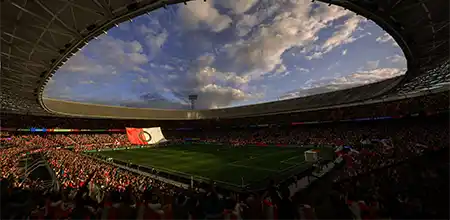Stadion Feijenoord
| Official Stadium Name | Stadion Feijenoord |
| Former Names | |
| Alternative Names | De Kuip |
| Inauguration Date | 27/03/1937 |
| Opening Game | Feyenoord |
| Opening Game Date | 27/03/1937 |
| Attendance Record | |
| Record Match | |
| Record Date | |
| Renovations | 1941, 1958, 1994 |
| Design | Leendert van der Vlugt |
| Cost | |
| Owner | |
| Operator | Stadion Feyenoord NV |
| Tenants | |
| League | |
| Pitch Dimension | 105x68 meters |
| Surface | Grass |
In-Game Details
In-Game Video

Real Video
Stadium History
Construction of the new stadium for Feijenoord began in 1935 to accommodate the club’s growing fanbase. Financed in part by billionaire van Beuningen, this venue became a model for other stadiums, including Camp Nou in Barcelona. Club president Leen van Zandvliet, inspired by stadiums in London and New York, worked with architect Leendert van der Vlugt, who used steel, concrete, and glass to create a functionalist design.
Completed in 1937, Feijenoord Stadion, known as ‘De Kuip’ (The Bathtub), could hold up to 64,000 spectators on two-tiered stands with unobstructed views—a rarity at the time. During WWII, the stadium narrowly avoided being dismantled by the Germans for its steel. Despite several redevelopments, ‘De Kuip’ has retained its original 1937 design, including its iconic floodlight masts and nearly untouched facades. Named a Rotterdam monument, the stadium has hosted nearly 150 Dutch national team games, served as the main venue for Euro 2000, and been the site of 10 European club competition finals.

 Eredivisie
Eredivisie

 Sunny
Sunny Snow
Snow Rainy
Rainy Cloudy
Cloudy





